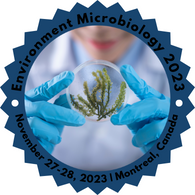
Nahla Omer Eltai
Qatar University Biomedical Research Center
Title: Innovative Application for the Mitigation of Airborne Pathogens
Biography
Biography: Nahla Omer Eltai
Abstract
Transmission of respiratory diseases, such as tuberculosis, aspergillosis, and recently Coronavirus disease 2019 (COVID-19) pandemic threatened the lives of millions, causing thousands of deaths worldwide and resulting in a worrying global health crisis highlighting the airborne transmission crucial role in the transmission of infections. HEPA filters are the current industry standard. Nevertheless, they must be used with other air cleaning methods as they present a high-pressure drop to the airflow and consume fan power. In addition, HEPA filters are expensive and must be frequently changed. Here a new device presented for air cleaning was developed and evaluated for efficiency by the Faculty of Engineering and Biomedical Research Centre (BRC). The device uses Electrically Activated Water (EAW), which could be integrated into current Heating, Ventilation, and Air Conditioning (HVAC) systems.
In this study, a modified integrated air cooling portable unit was developed to accommodate the EAW-wicking system and the HEPA filter that can be used to mitigate airborne diseases. A known amount of E. coli, Aspergillus spp., and Newcastle virus were nebulized in a contained space using an automatic nebulizer. The efficacy of the prototype and a combination of the developed prototype and HEPA filters were compared and assessed through different techniques. After each cleaning period, the bacteria were quantified by sampling into nutrient agar plates consuming Cascade Impactor. Newcastle virus was collected using an SKC aerosol sampler, and viral load reduction was determined using TCID50/ml and RT-qPCR, while antifungal activity was determined by inhibiting fungus growth. A preliminary lab air cleaning analysis demonstrated the significant efficiency of the novel prototype. The technology also showed efficacy in the simulated tertiary hospital and stadium environment. In conclusion, towards the end of this project, we are working to build a certified commercial prototype at the TRL8 level to remove infectious pathogens. The application is novel and commercial and will have a global influence on infection control strategies in hospitals and indoor public locations by providing a safe, pathogens-free environment

